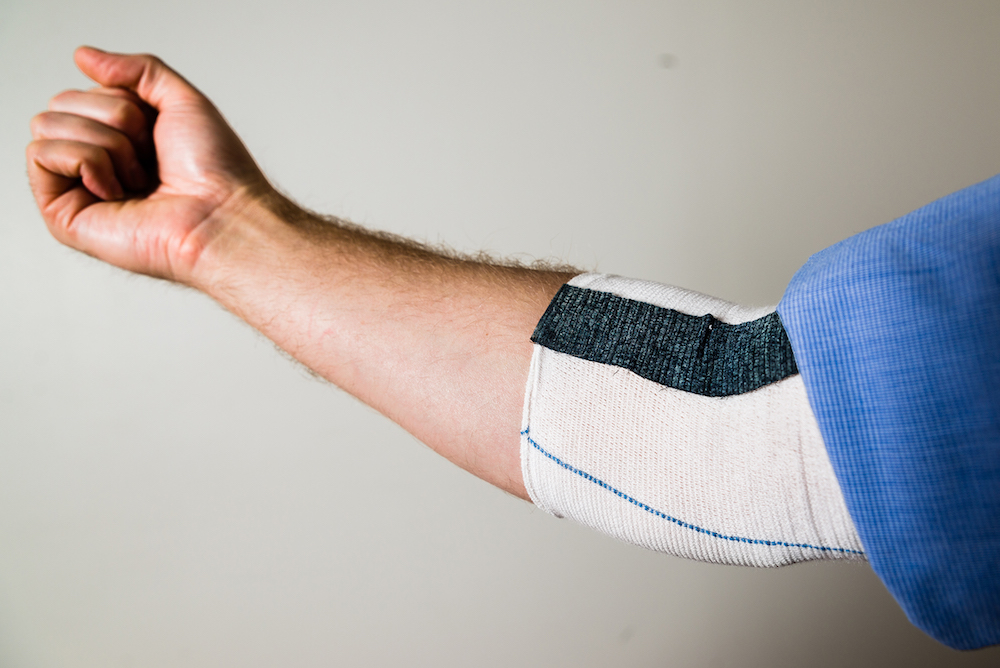
Knitting and weaving artificial muscles could help create soft exoskeletons that people with disabilities could wear under their clothes to help them walk, according to new research.
Textile processing is one of humanity's oldest technologies, but in recent years there has been renewed interest in using it to create "smart" textiles that can do everything from harvest power from the environment to monitor our health.
Now, Swedish researchers have created actuators — devices that convert energy into motion — from cellulose yarn coated with a polymer that reacts to electricity. These fibers were then woven and knitted using standard industrial machines to create textile actuators, dubbed "textuators" by the researchers. [Top 10 Inventions that Changed the World]
Exoskeletons can be used to boost humans' weight-lifting abilities or help the disabled walk, but they rely on electric motors or pneumatic systems that are bulky, noisy and stiff. The researchers say their approach could one day help mass-produce soft and silent exoskeletons using textile-processing technology, as well as actuators for soft robotics.
"Our dream is suits you can wear under your clothing — hidden exoskeletons to help the elderly, help those recovering from injury, maybe one day make disabled people walk again," said Edwin Jager, an associate professor in applied physics at Linköping University in Sweden, who led the research.
The team started with cellulose yarn, which is biocompatible and renewable, and knitted and weaved it into a variety of textiles. These textiles were then coated with a conducting polymer called polypyrrole (PPy) using a process similar to how commercial fabrics are dyed.
PPy has been widely used to create soft actuators because it changes its size when a low voltage is applied to it, thanks to ions and solvents moving in and out of the polymer matrix. As this material coats the fiber, it contracts when a positive voltage is applied and expands when a negative voltage is applied.
Sign up for the Live Science daily newsletter now
Get the world’s most fascinating discoveries delivered straight to your inbox.
In a new study published online today (Jan. 25) in the journal Science Advances, the researchers found that weaving the fabric resulted in a textuator that produced high force, while knitting resulted in less force but an extremely stretchy material.
By varying the processing method and the weaving or knitting pattern, Jager told Live Science it should be possible to tailor the force and strain characteristics of a textuator to the specific application at hand. To demonstrate the capabilities of the approach, the scientists integrated a knitted fabric into a Lego lever arm and it was able to lift 0.07 ounces (2 grams) of weight.
Xing Fan, an associate professor of chemical engineering at Chongqing University in China, who also works on smart textiles, told Live Science the research was an interesting step toward commercially viable smart textile actuators, but added that there are still some issues to be overcome.
At present, the material still needs to be submerged in a liquid electrolyte, which serves as a source of ions for the PPy. The material also responds much more slowly than mammalian muscle, taking minutes to fully expand or contract.
"Nevertheless, I believe that after years of improvement, the day that a feasible smart textile actuator appears on the desk of a commercial investor is not far away," Fan told Live Science.
Jager said his group is already designing a second generation of textuators that will address these issues. Decreasing response time is simply a matter of reducing the diameter of the yarn to a few micrometers he said, which commercially available textile-processing machines are capable of doing. The researchers are also working on ways to embed the electrolyte in the fabric so that it can operate in air.
The group chose to work with PPy because it was a material they were familiar with, but a limitation is that achieving high force requires thick yarns, which slows response times. Jager said a key innovation was demonstrating that organizing multiple yarns in parallel — just like muscle fibers — was able to increase force without increasing response times.
"We don't see ourselves locked to this material, though; it's more a way of showing that we can use textiles with smart materials to create textuators," he said. "I'm not sure if ours is the best material, but hopefully, people who find better materials will be inspired and use this technique of ours as a starting point and improve from it."
Original article on Live Science.












